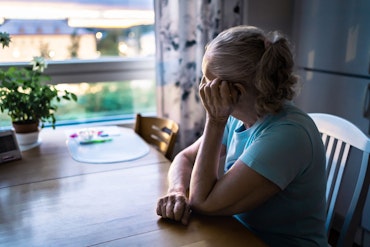2023 industry guidelines for aged care visitors during COVID-19
The new Sector Code was published on June 26, offering industry providers and people seeking aged care a sense of clarity during Australia’s flu season.
![<p>Older people in residential aged care are particularly vulnerable to severe symptoms of viral infections, such as COVID-19. [Source: Shutterstock]</p>](https://agedcareguide-assets.imgix.net/news/articles/wp/scowlingseniorstatedspecialist.jpg?fm=pjpg&format=auto&w=550&q=65)
Older people in residential aged care are particularly vulnerable to severe symptoms of viral infections, such as COVID-19. [Source: Shutterstock]
Key facts:
- Consumer and aged care advocacy collectives have established a Sector Code for Visiting Residential Aged Care Homes during COVID-19, based on the Department of Health and Aged Care’s National COVID-19 Health Management Plan for 2023
- The industry Code was developed with the aim of creating a perfect balance between isolation and resident safety
- Older Australians are more likely to experience severe symptoms as a result of viruses
The newly released Sector Code for Visiting Residential Aged Care Homes during COVID-19 was developed and endorsed by consumer and aged care advocacy groups as a way to protect older people from the spread of viral infection.
Notably, the guidelines support access to an essential visitor for aged care residents, even during lockdowns, to ensure that the mental wellbeing of older people is not put at risk. The Code was introduced in response to reduced State and Territory health guidance in 2023, following the initial response period of the pandemic.
The Code is strongly advising visitors to be up-to-date with vaccinations, including boosters [unless medically exempt] in order to reduce the risk of transmission, with a screening process to ensure that possible symptoms are vetted prior to visitation.
The following groups have played a role in producing the guidelines:
- Carers Australia
- Council on the Ageing [COTA] Australia
- Dementia Australia
- Federation of Ethnic Communities Council of Australia
- National Seniors Australia
- Palliative Care Australia
- Older Persons Advocacy Network [OPAN]
- Aged and Community Care Providers Association
- Anglicare Australia
- Baptist Care Australia
- Catholic Health Australia
- UnitingCare Australia
COTA Australia Chief Executive Officer [CEO] Patricia Sparrow, said that while striking the right balance is difficult, it’s also crucial.
“We know that prolonged isolation causes irreversible harm. Having a clear code that clearly states that residents are always permitted to have at least one visitor, regardless of the COVID-19 outbreak status, is incredibly important,” Ms Sparrow said.
“We need to ensure that the needs of older Australians are always front and centre. That includes ensuring their health is prioritised, both physically and mentally. The code provides clarity around how we can balance COVID precautions with the dignity and wellbeing of older Australians, including their often neglected mental health.”
OPAN CEO Craig Gear said the best way to balance the risk of infection with the mental, physical and nutritional impacts of social isolation, is prevention.
“We know older people are at higher risk of complications from COVID, so it’s important that all eligible residents have access to a booster vaccination,” said Mr Gear.
“We also know older people have been disproportionately affected by the previous waves of lockdowns. The aim is to balance the infection risk with the mental, physical, and nutritional impact of extended periods of social isolation.”
CEO of the Aged and Community Care Providers Association Tom Symondson said it’s vital we look after the health of older Australians, as well as their need for social interaction and time with family and friends.
“Australia is still learning how to live with COVID-19 and older Australians remain amongst some of the most vulnerable to the disease,” said Mr Symondson.
“Throughout the pandemic, aged care providers have strived to make sure older people are safe, but also ensuring family can still visit loved ones. We know that social isolation away from family is difficult and these new guidelines are about improving the lives of older Australians, while still protecting them.”
To read the new guidelines for yourself or find out whether a visitor qualifies as either a partner-in-care or a named visitor, check out the Sector Code online.























Comments